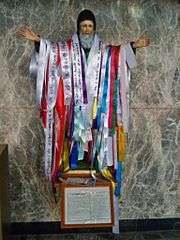Lebanese Mexicans
Lebanese Mexicans refers to Mexican citizens of Lebanese origin.
| Total population | |
|---|---|
| 991 Lebanon-born residents (2017)[1] est. 400,000 Mexicans of Lebanese descent[2] | |
| Regions with significant populations | |
| Nuevo León, Yucatán, Veracruz, Coahuila, Jalisco, Sinaloa, Mexico City, Baja California, Guanajuato, Chihuahua, Durango, Puebla | |
| Languages | |
| Mexican Spanish and Lebanese Arabic | |
| Religion | |
| Predominantly Christianity, minority Islam | |
| Related ethnic groups | |
| Lebanese and Lebanese diaspora |
| Part of a series of articles on |
| Lebanese people |
|---|
 |
|
Lebanese people
|
|
Communities Native communities outside of Lebanon:
Europe Overseas
Middle East |
|
Language |
|
Politics |
|
|
Although Lebanese Mexicans made up less than 5% of the total immigrant population in Mexico during the 1930s, they constituted half of the immigrant economic activity.[3]
Lebanese influence in Mexican culture can be seen most particularly in Mexican cuisine, where they have introduced many foods and dishes and created their own recipes such as al pastor.
Interethnic marriage in the Lebanese community, regardless of religious affiliation, is very high; most have only one parent with Lebanese ethnicity. As a result, some of them speak Arabic fluently. But the majority, especially among younger generations, speak Spanish as first language.
Carlos Slim, formerly the richest man in the world,[4] is an example of Lebanese Mexican success in Mexican society.
Migration history
Lebanese immigration to Mexico started in the 19th and early 20th centuries.[5] In 1892, the first Lebanese arrived in Mexico from Beirut in French ships to Mexican ports such as Puerto Progreso, Jalisco and Tampico. At that time, Lebanon was not an independent nation; the territory was held by the Ottoman Empire and later became a French protectorate. Roughly 100,000 Arabic-speakers settled in Mexico during this time period. They settled in significant numbers in Yucatán, Veracruz, Puebla, Mexico City and the northern part of the country (mainly in the states of Baja California, Nuevo León, Sinaloa, Chihuahua, Coahuila, and Durango, as well as the city of Tampico and Guadalajara).
Although Lebanese people made up less than 5% of the total immigrant population in Mexico during the 1930s, they constituted half of the immigrant economic activity.[3] During the 1948 Israel-Lebanon war and the Six-Day War, thousands of Lebanese left Lebanon and went to Mexico, first arriving in Veracruz.
Another concentration of Lebanese-Mexicans is in Baja California facing the US–Mexican border, especially in the cities of Mexicali and Tijuana across from San Diego with a large Lebanese-American community (about 280,000), some of whose families have relatives in Mexico.
Lebanese culture in Mexico

One Lebanese cultural tradition in Mexico itself is to place colored ribbons to the image of St. Charbel to ask some favor or some miracle (see Intercession of saints). The tradition arose in the Candelaria Church in Merced in the historic center of Mexico City.
The immigration of Lebanese to Mexico has influenced Mexican culture, in particular food, including introducing kibbeh and tabbouleh, and even creating recipes such as tacos árabes. By 1765, dates, which originated in North Africa and the Middle East, were introduced into Mexico by the Spaniards. The fusion between Arab and Mexican food has highly influenced the Yucatecan cuisine.
Religion
The majority of Lebanese-Mexicans are Christians who belong to the Maronite, Roman Catholic, Eastern Orthodox and Melkite Catholic confessions. The Lebanese initially practiced Catholicism independently from other Mexicans, but learned to speak Spanish; Lebanese-Mexican children quickly joined the country's mainstream religious activities.
A few Lebanese Muslims settled in Mexico. They were responsible for the opening of the first mosque in Mexico, built in the city of Torreon, in Coahuila, and named Suraya.
Notable people
Lebanese last names
Abbas, Abaid, Abudd, Aoun, Amione, Alhuseyni, Alabi, Ali Hagar, Almazan, Anuar, Assad, Awad, Ayoub, Ayub, Azar, Arelle, Bakri, Boudama, Barquet, Balouch, Bathich, Bichir, Bitar, Buhaya, Cafrune, Chagra, Chalt (Chalet), Chaul, Chuayffet, Curi, Chehayeb, Chedraui, Chidiac, Cejin, Daw, Dabdub, Dachar, Daher, Dipp, Dahdouh, Domit, Eljure, Farah, Fayed, Feris, Ganem, Guarch, Giacoman, Huirich, Hadad, Hagg, Hamed, Handal, Hajjar, Hayek, Harp, Harari, Hariri, Harawi, Harfoush, Hasbun, Helu, Henaine, Kury, Kuribreña, Kanaan, Karam, Khalil, Kharrat, Layun, Nader, Nasser, Nacim, Nacif, Nahas, Mabarak, Maalouf, Malooly, Mansour, Matuk, Marun, Menem, Meochi, Marrash, Massou, Masri, Medina, Menen, Merheg, Mukhtar, Moawad, Moor, Rafidi, Rahaim, Saad, Sabah, Saber, Salom, Salomon, Seade, Sfeir, Slim, Saeb, Sayde, Sroor, Shuaire, Touche, Vara, Yanar, Yapor, Yarad, Yazbek, Yunes.
See also
References
- "Table 1: Total migrant stock at mid-year by origin and by major area, region, country or area of destination, 2017". United Nations, Department of Economic and Social Affairs, Population Division. Retrieved 17 August 2018.
- "The biggest enchilada". The Telegraph. Retrieved 28 February 2015.
The Mexican-Lebanese community now numbers around 400,000 but punches way above its weight in commerce...
- "Los árabes de México. Asimilación y herencia cultural" (PDF) (in Spanish). December 2005. Archived from the original (PDF) on 2009-03-27. Retrieved 2010-04-17.
- "Carlos Slim Helu & family". Forbes. Retrieved March 5, 2013.
- "Marin-Guzman, Roberto and Zidane Zeraoui. Arab Immigration in Mexico in the Nineteenth and Twentieth Centuries: Assimilation and Arab Heritage.(Book Review)". Archived from the original on 12 January 2008.
External links
- Los que llegaron - Libaneses from Canal Once